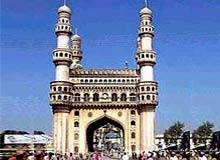 The Charminar in Hyderabad was constructed in 1591 by Mohammed Quli Qutab Shah. He built the Charminar to mark the end of plague in the Hyderabad city. Since the construction of the Charminar, the Hyderabad city has almost become synonymous with the monument. The Charminar is a massive and impressive structure with four minarets. In the evening, with illumination, the great Charminar looks even greater. With the passage of time the Charminar occupied so much importance that it became the heart of all bustling activities. It is in the bustling bazaars around the Charminar that you find the traditional nahari stalls and kulchas of Hyderabad. Hyderabad is one of those few cities, which have a fine blend of modernity and tradition.
The Charminar in Hyderabad was constructed in 1591 by Mohammed Quli Qutab Shah. He built the Charminar to mark the end of plague in the Hyderabad city. Since the construction of the Charminar, the Hyderabad city has almost become synonymous with the monument. The Charminar is a massive and impressive structure with four minarets. In the evening, with illumination, the great Charminar looks even greater. With the passage of time the Charminar occupied so much importance that it became the heart of all bustling activities. It is in the bustling bazaars around the Charminar that you find the traditional nahari stalls and kulchas of Hyderabad. Hyderabad is one of those few cities, which have a fine blend of modernity and tradition. The Charminar has four imposing arches, which face the four main directions. A row of small vaulted niches ornament each of the four arches. The Char Minar is a two-storied building with the first floor being covered. The balconies on this floor provide a great view of the surrounding areas. A small mosque
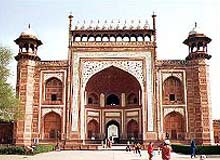 Buland Darwaza or the loft gateway was built by the great Mughal emperor, Akbar in 1601 A.D. at Fatehpur Sikri. Akbar built the Buland Darwaza to commemorate his victory over Gujarat. The Buland Darwaza is approached by 42 steps. The Buland Darwaza is 53.63m high and 35 meters wide. Buland Darwaza is the highest gateway in the world and an astounding example of the Mughal architecture. The Buland Darwaza or the magnificence gateway is made of red and buff sandstone,
Buland Darwaza or the loft gateway was built by the great Mughal emperor, Akbar in 1601 A.D. at Fatehpur Sikri. Akbar built the Buland Darwaza to commemorate his victory over Gujarat. The Buland Darwaza is approached by 42 steps. The Buland Darwaza is 53.63m high and 35 meters wide. Buland Darwaza is the highest gateway in the world and an astounding example of the Mughal architecture. The Buland Darwaza or the magnificence gateway is made of red and buff sandstone,  Aipan is one of the traditional forms of Rangoli, practiced in the state of Uttarakhand, now Uttaranchal. The art is associated with a great degree of social, cultural as well as religious significance. In Uttarakhand, Aipan designs are mainly drawn at
Aipan is one of the traditional forms of Rangoli, practiced in the state of Uttarakhand, now Uttaranchal. The art is associated with a great degree of social, cultural as well as religious significance. In Uttarakhand, Aipan designs are mainly drawn at 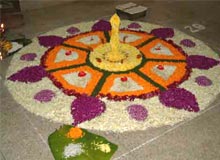 Kolam is the name given to the art of Rangoli in southern parts of the country, mainly the states of Kerala and Tamil Nadu. The Hindus residing in these parts make use of this art form on a
Kolam is the name given to the art of Rangoli in southern parts of the country, mainly the states of Kerala and Tamil Nadu. The Hindus residing in these parts make use of this art form on a 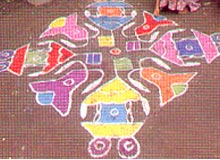 Aripana art form is a variation of the Rangoli, practiced in the Bihar. It usually comprises of line drawings, illustrated on
Aripana art form is a variation of the Rangoli, practiced in the Bihar. It usually comprises of line drawings, illustrated on 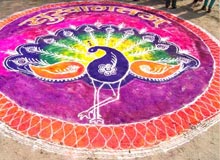 Rangoli, one of the most beautiful and most pleasing art forms of India, is comprised of two words, 'rang' meaning 'color' and 'aavalli' meaning colored creepers' or 'row of colors'. Rangoli basically comprises of the art of making designs or patterns on the walls or
Rangoli, one of the most beautiful and most pleasing art forms of India, is comprised of two words, 'rang' meaning 'color' and 'aavalli' meaning colored creepers' or 'row of colors'. Rangoli basically comprises of the art of making designs or patterns on the walls or 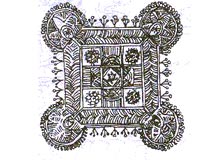 Alpana, the form of Rangoli practiced in Bengal, is a natural representation of the artistic sensibility of the people. Practiced usually by the womenfolk of the state, the art form represents an amalgamation of the past experience as well as the contemporary designs. Even though the basic designs are more or less same,
Alpana, the form of Rangoli practiced in Bengal, is a natural representation of the artistic sensibility of the people. Practiced usually by the womenfolk of the state, the art form represents an amalgamation of the past experience as well as the contemporary designs. Even though the basic designs are more or less same, 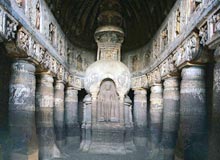 Ajanta Cave Temple is the marvelous architectural wonder that depicts the rich legacy of India. Acknowledged as the world heritage site, Ajanta Caves are renowned throughout the Globe. Located near Aurangabad, Ajanta Cave Temple can be reached easily from anywhere in Maharashtra by means of regular tourist buses or by hiring taxis. The nearest airport is located at Aurangabad that lies at a distance of 99 kms from the temples. The charisma, of these caves, attracts millions of visitors each and every year.
Ajanta Cave Temple is the marvelous architectural wonder that depicts the rich legacy of India. Acknowledged as the world heritage site, Ajanta Caves are renowned throughout the Globe. Located near Aurangabad, Ajanta Cave Temple can be reached easily from anywhere in Maharashtra by means of regular tourist buses or by hiring taxis. The nearest airport is located at Aurangabad that lies at a distance of 99 kms from the temples. The charisma, of these caves, attracts millions of visitors each and every year. 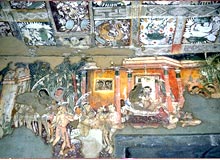 Cave paintings of India date back to the prehistoric times. The finest examples of these paintings comprise of the murals of Ajanta, Ellora, Bagh, Sittanavasal, etc, which reflect an emphasis on naturalism. Ancient cave paintings of India serve as a window to our ancestors, who used to inhabit these caves. In the following lines, we have provided more information on the ancient Indian rock paintings:
Cave paintings of India date back to the prehistoric times. The finest examples of these paintings comprise of the murals of Ajanta, Ellora, Bagh, Sittanavasal, etc, which reflect an emphasis on naturalism. Ancient cave paintings of India serve as a window to our ancestors, who used to inhabit these caves. In the following lines, we have provided more information on the ancient Indian rock paintings: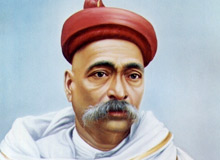 Bal Gangadhar Tilak was a social reformer and freedom fighter. He was one of the prime architects of modern India and strongest advocates of Swaraj (Self Rule). He was universally recognized as the "Father of Indian Movement". Tilak was a brilliant politician as well as a profound scholar who believed that independence is the foremost necessity for the well being of a nation.
Bal Gangadhar Tilak was a social reformer and freedom fighter. He was one of the prime architects of modern India and strongest advocates of Swaraj (Self Rule). He was universally recognized as the "Father of Indian Movement". Tilak was a brilliant politician as well as a profound scholar who believed that independence is the foremost necessity for the well being of a nation.  A distinguished maestro in
A distinguished maestro in  Alka Yagnik is one of the leading singers of the Hindi film who has made an indelible mark for herself. In an industry where big and already established names were ruling, it was not easy for anyone to even get noticed. But real talent never goes waste and she finally got her big break after which there was no turning back. Born in Calcutta on 20th March in a Gujarati family, Alka Yagnik began showcasing her talent at a very young age. Today, the chart topping songs of Alka Yagnik are a favorite of many. Check out her life history in this biography of Alka Yagnik.
Alka Yagnik is one of the leading singers of the Hindi film who has made an indelible mark for herself. In an industry where big and already established names were ruling, it was not easy for anyone to even get noticed. But real talent never goes waste and she finally got her big break after which there was no turning back. Born in Calcutta on 20th March in a Gujarati family, Alka Yagnik began showcasing her talent at a very young age. Today, the chart topping songs of Alka Yagnik are a favorite of many. Check out her life history in this biography of Alka Yagnik. 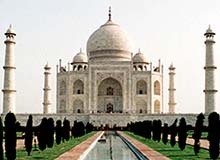 Famous as one of the wonders, the Taj Mahal at Agra, India, is epitome of true love. Taj Mahal was built by the famous Mughal emperor Shah Jahan in the memory of his beloved wife, Mumtaj Mahal. The
Famous as one of the wonders, the Taj Mahal at Agra, India, is epitome of true love. Taj Mahal was built by the famous Mughal emperor Shah Jahan in the memory of his beloved wife, Mumtaj Mahal. The